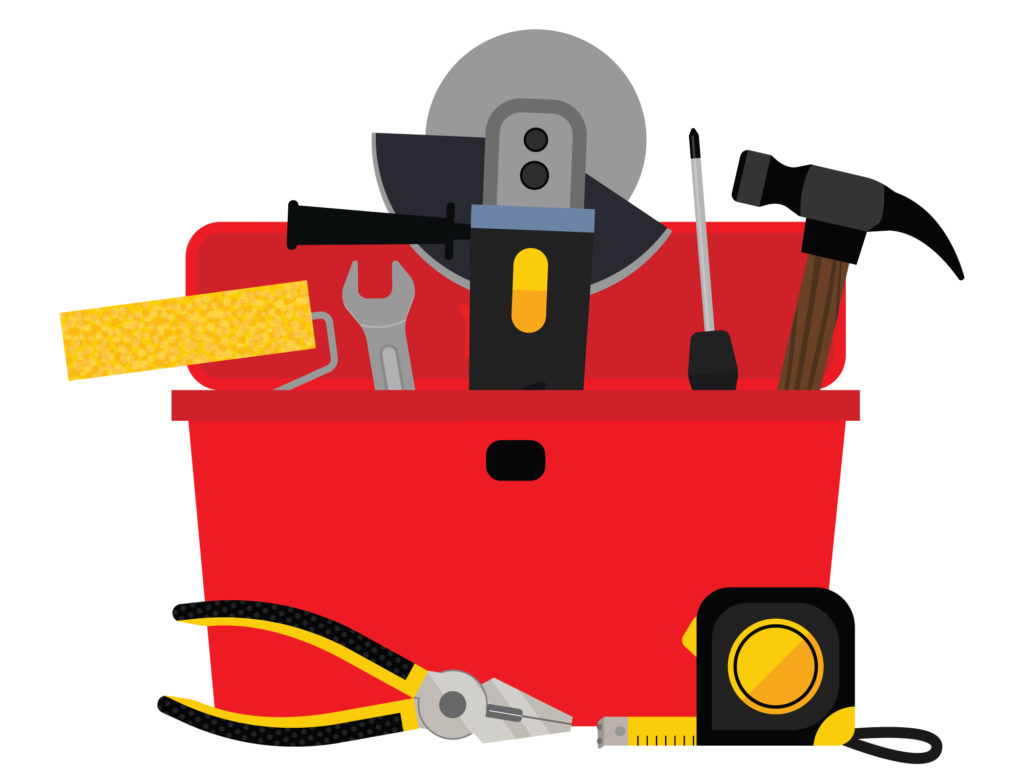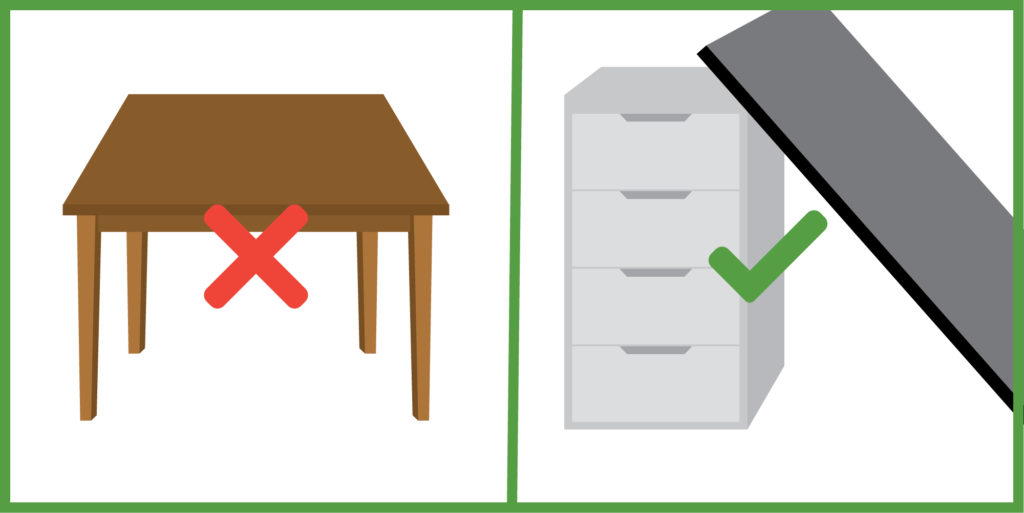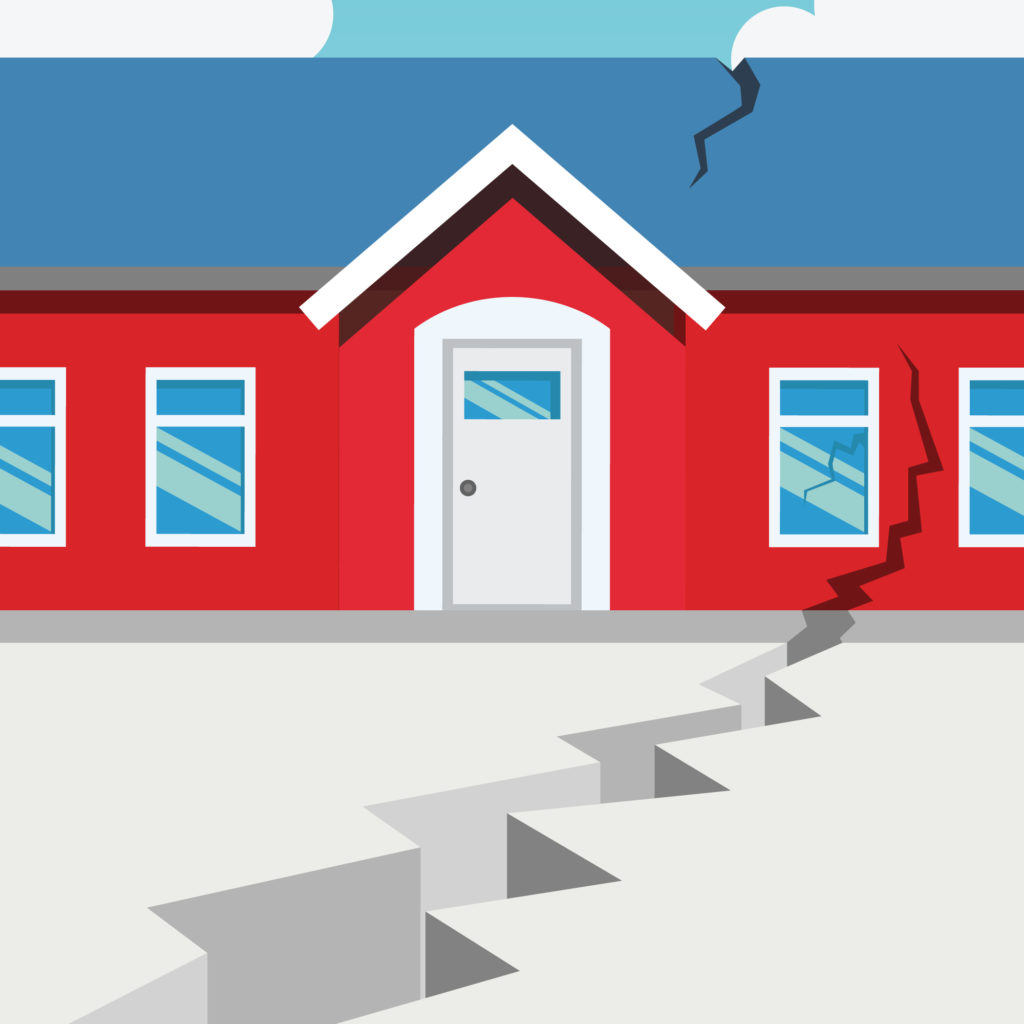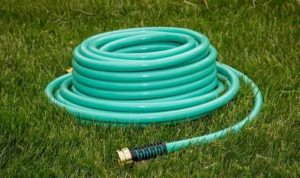Earthquakes are a natural disaster that are hard to predict and sudden. Residents that fall victim to one of these earth-shaking phenomena know the fear and danger that they bring in their wake.
While most earthquakes are small and harmless, it is always best to prepare for disaster ahead. Prepare your home and property for an earthquake disaster with this guide and protect yourself and your family from potential hazards and injuries.
Table of Contents
- Safety First
- Preemptive Measures
- Get Earthquake Insurance
- Identify Safe Areas in Your Home
- Identify A Meeting Point In Case You Get Separated
- Run Practice Drills
- Save Important Contact Information
- Prepare an Earthquake Kit
- During the Earthquake
- After The Earthquake
- Prepare For The Next Earthquake
- Keep Your Pets Safe
- Keep Your Family Safe
- Earthquake Preparedness
Safety First
Creating a readiness plan will ensure that your family is on the same page if disaster strikes. A readiness plan will cover things like meeting locations, emergency escape plans, and other important details.
Earthquake kits should be prepped ahead of time. These kits will include things like first aid kits, food, water, important documents, and flashlights. Keep a list of phone numbers to emergency services, doctors, veterinarians, friends/family, and other essential places.
Having a properly stocked kit prepared will keep you covered in case you are trapped without power. Follow guidelines set by FEMA to build a perfect kit that suits the needs of you and your family – including your pets.
Preemptive Measures
Aside from earthquake kits and readiness plans, there are some things you can do around the home to help prepare.
Prepare Your Home
Everything from the trees around your home to the walls and roof will need to be checked prior to an earthquake. Many of these things will need to be reevaluated after potentially strong earthquakes, as well. If damage is caught afterwards, you should take immediate action
Evaluate Your Home
You can hire places to come check your home for potential dangers. If you are inspecting the infrastructure of your own home, pay close attention to details. Things like power lines can be potentially deadly if they fall down, so you may want to get an estimate on removing tree or cutting back limbs that could fall on the wires or your home.
Secure the Foundation
Ensuring that your home is securely fastened to the foundation is necessary. For homes built prior to 1950, there is a high chance that there are no bolts connecting the wooden frames to the concrete foundation.
Using a carbide bit, you can use a hammer drill to drill through the sill plate into the foundation. These holes should be equal distance apart from one another.
Mending plates, joist hangers, “T” and “L” straps, and twin post caps need to be strengthened to help maintain the structure of your home in the event that an earthquake strikes.
Check the Chimney for Stability
Along with your roof, the chimney will need to be evaluated for loose tiles or bricks. A worthwhile consideration to keep you safe from falling bricks is to reinforce the ceiling around the chimney. A ¾-inch plywood can be nailed to the ceiling joists for added stability.
Professionals can evaluate the state of your chimney for you, if you prefer.
Secure Utility Lines
This aspect of securing your home is vitally important. Your family needs to know how and where to shut off utilities. This can be done at the main switch or individual valves.
For your water heater, simply bolt it in place and then install a special strap to keep it fastened and in place.
Automatic valves are available for those that have gas utilities. These valves shut off the gas in the event of an earthquake. Remember, do not use anything that generates a spark after an earthquake; this includes using light switches and plugging things into wall outlets.
Shut off electricity to the circuit breaker can help prevent electrical damage and fires.
Make Necessary Repairs

It is hard work to get your home earthquake ready, and you are possibly going to have to make some other repairs.
Install Windows with Round Corners
Rounded windows are aesthetically pleasing, but they also serve a purpose in earthquake prone areas. The round shape of the windows prevents the corners cracking and chipping of the windows when an earthquake causes pressure to shift the frames.
You do not have to go full circle with the windows, as there are now options for mostly square frames with simple, rounded corners.
Secure Large Equipment, Furniture Pieces, and Appliances
Anchoring large furniture to each other or a wall is a good idea. Falling bookshelves, hutches, or dressers can cause injuries and damage your home further. Not only that, but the things inside can break if they fall. Strapping these things to the wall now will save you time and effort after an earthquake.
Using special straps, you can anchor your refrigerator and other large kitchen appliances to each other. Anti-tip fasteners may also be useful to prevent damage for larger appliances and furniture.
Safety Locks for Cabinets
Don’t forgo this one just because it might cause some inconveniences in your daily life. Your cabinets are probably filled with containers that can roll under things or even glass jars with oil, vinegar, or wine. Safety locks prevent huge messes that can be caused by even small earthquakes.
Be sure to measure your cabinets and do your research. There are some great safety locks that are mostly hidden and will open with one hand.
Store heavy Items on Low Shelves
Heavy items can act as an anchor for bookshelves and other storage units. This is why it is always best to keep heavier items on the lowest shelves.
Heavy pictures or other wall hangings should not be placed above where people sit or sleep.
Keep a Generator
If your power goes out for an extended period, you will not regret having purchased a generator. Generators provide power to your home, but their power greatly depends on the size of the generator that you purchase. Make note of everything that you will need during an outage and search the appliance for its wattage. You can use the total number to determine the size of generator that you will need.
Equipment that you want to use can be plugged directly into the generator. Improper use can lead to carbon monoxide (CO) poisoning. It is important that you follow the manufacturer’s guidelines for safety precautions with your generator.
Get Earthquake Insurance
Earthquake insurance will be able to help you cover the damages in your home and property after the earthquake has affected your area, and it can be bought as an addition to homeowners or renters insurance. It may not be able to help you recover absolutely everything, but it will be able to provide you with a bigger peace of mind and help you with the recovery process. Earthquake insurance will help cover your home, your personal belongings, or help provide you with a new living space if your house is no longer capable of housing you and your family.
Identify Safe Areas in Your Home

One of the most important things to do is to identify safe areas where you and your family can go in case disaster strikes. If you are indoors, stay low to the ground to avoid getting knocked over during the earthquake and take cover underneath a desk or table and stay away from any pieces of furniture that can fall over on you. If you are outdoors, go to a more open space away from buildings, trees, power lines, and vehicles that can become damaged and fall over on you.
Safe Places Can Be
If you are inside of a building with multiple floors, avoid using an elevator and avoid the windows of the building as much as you possibly can. Hold on to any firm and solid structure you can find and make sure to hold on tight. Be sure to stay still during the duration of the earthquake to avoid being knocked over and possibly injured.
Identify A Meeting Point In Case You Get Separated
A proper and safe meeting place should be a solid piece of your family disaster plan. There is always the possibility that you could get separated from the rest of your family after an earthquake strikes, so you will have to figure out where everyone will meet up after the earthquake is over if that happens. Make sure you have a reliable form of communication in case someone gets lost, and that you and your family have proper directions to the meeting spot. Designating a meeting place will help ensure your safety and the safety of your family in the face of sudden disaster.
Run Practice Drills
Learning how to practice earthquake drills will help you and your family be more prepared for when disaster strikes and should be considered a standard protocol for earthquake preparation. These drills could potentially save lives if they are carried out efficiently. In order to carry out a practice drill, you must follow these steps in order to form a proper plan of action.
First, schedule times to carry out your drill and make sure everyone in your household will be able to attend. Reenact the sounds of an earthquake by downloading special sound effects to simulate the sounds of an earthquake striking to make it more realistic. When the drill starts, everyone should find a place to stop, drop, and hold onto something that will keep them firmly in place.
These practice drills should also have adjustments for physical handicaps (wheelchairs, casts, etc.) and family pets. A drill for your family will only be effective if it includes everyone’s safety. Make sure that your family is able to gather their bearings and locate where the emergency kits are near the end of the drill to complete the preparation process.
Save Important Contact Information
Setting up an emergency communication is key to the survival of your family. Be sure that you have a copy of your emergency contacts on hand in your earthquake preparation kit in case you need to contact friends or family members that can help you in the case of high-risk disasters. Earthquakes are infinitely unpredictable, so it is good to have a bit of control by knowing who to contact and where to go when things get almost too rough to handle.
The emergency communication plan you develop for your family should include a designated meeting place, contact information cards, a communication team, and any out-of-town emergency contacts. If you have children, keep your contact information laminated somewhere within their backpacks so they will be able to contact you or know where to go when disaster strikes.
Set up a timeline for communication after the earthquake is over to ensure that your family is safe. Keep the length of communication short, but also make sure that it is reliable enough to be able to reach your family members. If you do not have a phone available after the earthquake, make sure you have another reliable form of communication on hand to let everyone know that you are safe.
Prepare an Earthquake Kit
You should always have an earthquake kit prepared, especially if you live within a high-risk zone. Many of the items that you should include in an earthquake kit are items that you would usually find within common first aid kits, which would be items such as medicine, bandages, ointment, hydrogen peroxide, medical equipment, and any kinds of medication you normally take for yourself. Other items would include ropes, packs of water, matches, ready to eat canned foods, etc.
You should always keep an earthquake kit prepared in your home and in your vehicle in cases of emergencies. The kits that you keep in your vehicle should consist of blankets, flashlights and batteries, clothes, emergency signal devices, a map and compass, tools, etc. Make sure you have items that everyone in your family will need, especially if any of you have specific medical issues that requires proper handling.
Sometimes, you may even need to include an extra bit of cash in your earthquake kit in case you need to restock on tools, medical supplies, food, water, or clothes. You will also need it to put gas in your vehicle in case you need to relocate to a safer area until the disaster has settled down and been taken care of. You should also always keep a copy of a list of emergency contacts and the emergency plan you have created for your family in case any of you end up in deeper trouble than you planned for.
During the Earthquake

Practice Duck Cover and Hold
We should all know what duck, cover, and hold is from our old lessons in school, but when a real earthquake hits, it’s easy to forget what you should do. First, duck, or drop to the floor.
Then take cover underneath some piece of sturdy furniture. If there’s no sturdy furniture around, cover yourself against an interior wall and protect your head and neck with your arms. You want to be careful to avoid any spots near windows, hanging objects, mirrors, or any tall furniture.
Finally, hold your position. Be prepared to remain in your position until the ground stops shaking and you’re sure that it is safe to move.
If You’re Driving
Quickly pull over to the side of the road and stop. You’ll want to avoid stopping yourself in any overpasses, near any powerlines, and away from any possible hazards. Do not move from your vehicle until the shaking is over.
If You’re Outside
Run to a completely clear area. This means that you should be away from trees, signs, buildings, or any fallen electrical wires or poles. This is to ensure that nothing will fall on you.
If You’re On a Sidewalk Near Buildings
Duck into a doorway to protect yourself from any falling bricks, glass, or other debris.
If You’re In The Kitchen
Get away from anything that can fall on you, meaning your refrigerator, stove, and those overhead cupboards. If you’ve prepared beforehand, you should try to anchor your appliances and install security latches on all of your cupboard doors. This will prevent everything from falling down on you in the event of an earthquake.
If You’re In a Stadium Or Theater
Stay in your seat. Like the cover technique, protect your head with your arms and do not move until the shaking is over. Then try to leave in a calm manner in the case of aftershocks.
If You’re In a Wheelchair
Try to get to somewhere safe, but if you can’t, reach down and lock your wheels. Bend over and cover your head with your arms, or if there’s something like a book or a pillow within reach, hold that over your head to keep you safe. Stay in this position until the shaking stops.
Stay Away From Objects That May Shatter
Anything in your home can shatter when your house is literally shaking. Windows are especially problematic, or any other glass items you have in your home. There are also items like unanchored bookcases, cabinets, refrigerators, or any other furniture. Especially furniture that is tall—avoid these items to keep yourself safe. Stay away from any chimneys that might lose some bricks on the way down too.
After The Earthquake
First off: stay calm. It might be difficult, but stay calm and stay in place. Be prepared that there might be another aftershock. Then pull up your phone or find a television. The media will have instructions on what you should do, but only make any calls if you need emergency help.
Once you can move, put on some sturdy shoes and protective clothing to keep yourself safe. If you’re okay to walk around, check to make sure that your home is safe. Leave if you determine that it isn’t, and be sure to take your emergency kit or any essential items with you.
Beyond grabbing the right items, make sure that you have food and water in case there’s no way to buy any, and if you’re still in your house, be careful with flushing toilets or any spilt materials or broken items.
Be Prepared For Aftershocks
Remember that after an earthquake, it’s highly likely that there will be aftershocks. To avoid being hurt by more falling items, stay away from any damaged items and out of the way of anything that is already damaged.
But remember that aftershocks might not occur right away. An aftershock can occur minutes, days, or months after the initial earthquake. Just remember to drop, cover, and hold if there’s ever shaking again.
Check For Injury
Check yourself and others for injuries right after an earthquake as soon as you’re sure that you’re in a safe spot. Look around for your first aid kit and make sure that you have some way to get information or contact others.
If you notice that someone is bleeding, put pressure on the wound. Use any clean cloth that you have. If they aren’t breathing, do CPR on them. Otherwise, don’t move any injured persons unless they’re in danger if they aren’t moved. Be sure to call for medical help, and to check any children or others who might need help.
Inspect Your House For Structural Damage
Once you’re sure that you and others are safe, check your home. Be sure that there are no small fires that may escalate, and shut off any gas in your home so that there’s no danger of gas leaks. Shut off your power too before you unplug any broken lights or appliances.
Stay In Contact
Keep in contact either with others or with the news. You should still be able to get news on your phone, but if you’re unable to, find a TV, radio, or another public system that will provide you all the information you need about the situation.
Prepare For The Next Earthquake
If you noticed structural issues around your home during the last earthquake, the time to fix them is now. Check on anything in your home that can move or fall during a quake, and tie down items like refrigerators and bookcases for next time.
Next, create some sort of disaster supply it. Be sure that you have food, water, and other basic items that will keep you alive for at least 72 hours in case something happens.
Then, develop some sort of emergency communication plan. Don’t rely only on cell phones or anything else that needs electricity, but instead develop a plan beforehand to meet up with your family in case you’re separated.
Keep Your Pets Safe
Safety Tips for Pets
Any pet will be frightened during an earthquake. Be sure to keep yourself in mind first. This sounds callous, but your pet will try to run and restraining them will not work.
Try to hold on if you can, but let your pet run to safety on their own and protect yourself instead. Animals are good at finding safety, so you will likely be able to find them after the quake.
Keep Your Family Safe
The best thing you can do to keep your family safe is to make sure that they know what to do during an earthquake. Have a preparedness plan put in place so that everyone knows what to do. Try to sketch out a floor plan as well, and show second exits in case someone gets blocked in.
Earthquake Preparedness
Always stay prepared. You might never think that you’ll never have to experience an earthquake, but it’s also best to stay prepared to protect lives and avoid any possible injuries.
If anything, that emergency kit you make will come in handy for a lot more than earthquakes.




